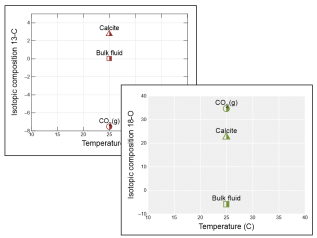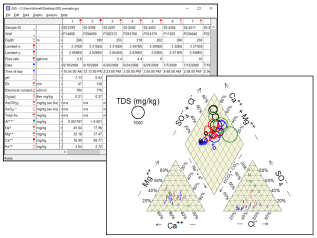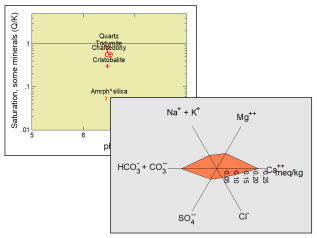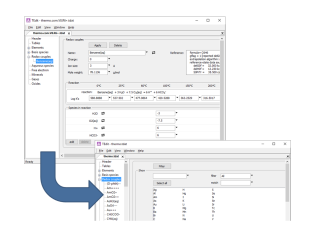The Geochemist's Workbench® 2025 Community Edition
Life just got easier! Powerful user-friendly #geochemistry tools free to all. Well done @GeochemWB!
– Matt Kirk, Kansas State University, via Twitter
This is an outstanding opportunity! Thank you, thank you!
– Rob Benson, Adams State University
It was difficult to use the GWB in our university. Now it is easy! Thank you!!!
– Laura Crossey, University of New Mexico
The Geochemist's Workbench® has from its introduction in 1991 set the standard in geochemical modeling. Thousands of copies have been licensed and installed in more than 90 countries around the world.
With its crisp user interface, fully integrated graphics, highly optimized algorithms, and advanced software architecture, the GWB makes quick work of geochemistry tasks small and large. With just a few clicks, GWB Community Edition balances reactions, figures equilibrium constants, and produces Eh-pH (Pourbaix) and activity diagrams. The package features a spreadsheet designed to hold and manipulate your geochemical data.
GWB Community Edition is available at no charge for everyone. Download GWB Community from our community page. You'll be up and running in no time. Your license will last for a year, after which you'll need to get a new license.
GWB Community runs under Windows 11 and 10. You can also run the software on a Mac using virtualization software such as Parallels Desktop.
The abilities of GWB Community are summarized below. Paid versions offering advanced features such as reaction path simulation and reactive transport modeling are available as upgrades.
Spreadsheet for geochemists
Program GSS is the Geochemist's spreadsheet, designed to hold and manipulate your chemical analyses. Paste in your data and you can:
- Convert chemical units
- Compute mineral saturation, gas fugacity
- Check for charge balance and figure TDS
- Figure aqueous species distribution, redox state
- Compare replicates and check standards
- Produce time series, cross plots, and ternary plots
- Make Piper, Stiff, Durov, ion balance diagrams
And much more. Still keeping your analyses in Excel?
Reaction balancing
Program Rxn uses an intuitive basis swapping method to balance chemical reactions and compute reaction properties. From the concise graphic user interface, you can:
- Balance reactions among aqueous species, minerals, solid solutions, and gases
- Calculate equilibrium constants—log Ks
- Compute free energy changes of reaction
- Identify spontaneous, equilibrium, and endergonic reactions
- Figure equilibrium equations
- Determine equilibrium temperatures
Eh-pH and activity diagrams
Programs Act2 and Tact produce diagrams showing areas of predominance for aqueous species, and stability ranges of minerals, solid solutions, and gases. Set as axis variables:
- Eh and pH, including Pourbaix diagrams
- Aqueous species activity
- Gas fugacity
You can also make:
- Solubility diagrams
- Mosaic diagrams
- Temperature-activity diagrams
Distribution of species
SpecE8 calculates the distribution of mass among aqueous species. Use the program to:
- Figure concentration, activity, activity coefficients
- Calculate mineral saturation indices
- Compute gas fugacity and partial pressure
- Temperature effects on speciation
- Plot Piper, Stiff, Schoeller, ion balance diagrams
- Debye-Hückel methods, SIT, and “Pitzer equations”
- Ideal and Guggenheim solid solutions
- Model sorption, ion exchange, surface complexation
Isotope fractionation

SpecE8 also computes the equilibrium isotope fractionation in a geochemical system:
- Among aqueous species, on a per-species basis
- Between minerals, gases, and fluid
- Input is fluid's bulk isotopic composition
- Data included for 2H, 13C, 18O, and 34S
- Extensible for any element with a dominant mass
- Multiple isotopes per element (e.g., 17O, 18O)
Thermo data editor
TEdit is a graphical editor for creating and modifying thermodynamic and surface reaction datasets. You can:
- View and edit data tables, species, reactions, log Ks, solid solutions, and virial coefficients
- Add, delete, sort, or copy and paste entries
- Rebalance reactions and recalculate log Ks
- Couple and decouple redox reactions
- Convert PhreeqC datasets to GWB thermo and surface datasets
- Import and export EQ3/EQ6 thermo databases
Need more power?
You can upgrade your Community Edition license to GWB Standard or GWB Professional. Please visit our main GWB website for more information.




